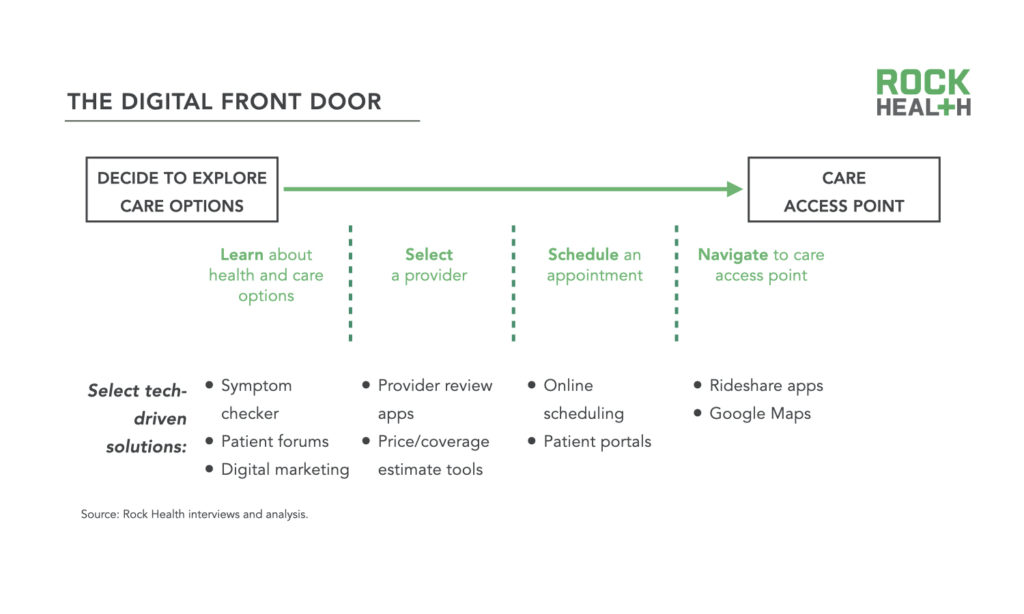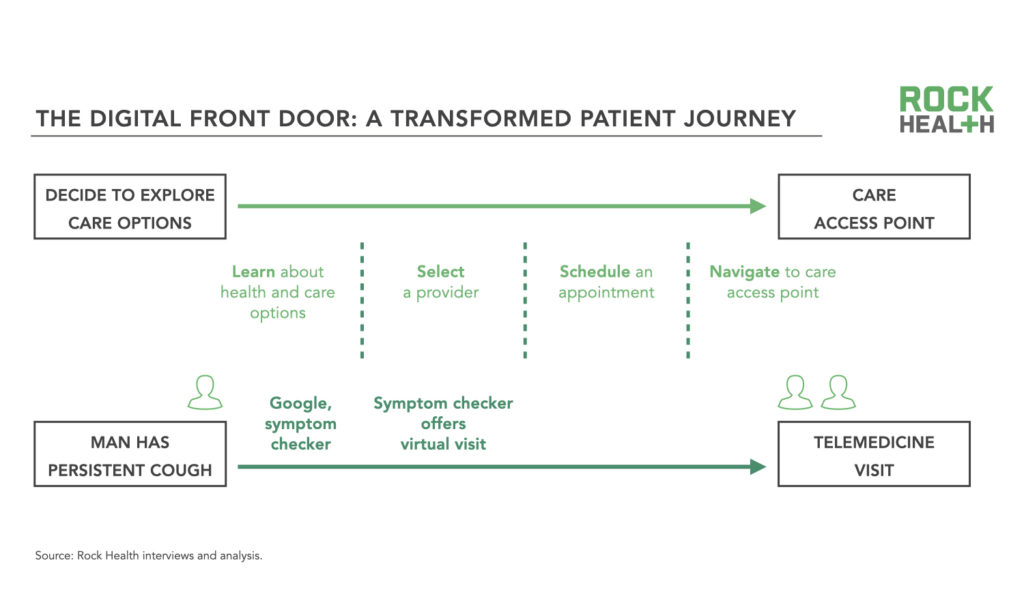Winning at the digital front door
Interested in the full report? Email advisoryservices@rockhealth.com to learn more about becoming a Rock Health Partner.
The COVID-19 pandemic has created unprecedented demand and urgency around the shift to digital content, navigation, and delivery of healthcare. Even before COVID-19 hit, consumers were leveraging digital solutions at increasingly high rates. According to Rock Health’s 2019 Consumer Adoption Survey, that year, 76% of US consumers went online to learn about their health and care. 64% searched for provider reviews online. Nearly half digitally tracked a health metric like their weight or blood sugar levels. And 60% brought information they found online into conversations with their providers.
Despite this increasingly ubiquitous digital behavior among US healthcare consumers, most health systems aren’t keeping track of—or building a strategy around their digital footprint, i.e., the entirety of patients’ digital experiences as they interact with a health system, including brand awareness, care navigation and access, and ongoing management. Without a strong digital presence and strategy, health systems are missing a significant opportunity to engage, and re-engage, patients throughout their healthcare journey. Consumers’ expectations have long been primed for the digital transition in healthcare—doubtlessly something incumbent healthcare leaders have heard before—but forward-looking health systems and consumer brands are rising to this unique moment with digital footprints that meet consumers online. The maturation of healthcare’s IT ecosystem and an increasingly responsive policy environment make this moment different than the past.
Here are five ways health systems can build—or refine—their master digital footprint.
1. Rightsize the ambition. A master digital footprint should include a digital front door experience that initiates the consumer care journey. When building this front door, health systems should rightsize their ambition to not just replace analog processes with digital ones. Instead, they should aim to design a front door experience that is proactive, efficient, and integrated. The following definition and example serves to distinguish between a “typical” front door interaction and a transformative experience.

The digital front door journey is bounded by two events. It begins when a consumer decides to explore care options—this could be motivated by a number of factors: having symptoms, needing a referral, receiving a notification from a health app, etc. Once on this pathway, the consumer uses digital tools to navigate to a care access point, which can take many forms, including but not limited to: a telemedicine visit, PCP encounter, prescription pickup at a local pharmacy. Front door journeys can be quite varied, but tend to include four key stages:
- Learn about health and care options
- Select a provider
- Schedule an appointment
- Navigate to a care access point

When building a digital front door, too many organizations are simply replacing a patient’s analog experience—like calling to schedule an appointment—with a digital one. But digital replacement is not digital transformation. Progressive providers will move beyond this to a reimagined experience, in which navigating via the digital front door transforms the consumer experience to be proactive, efficient, and integrated.
Take a consumer who has a persistent cough. He Googles his symptoms. The first link is an online symptom checker, which he uses to get a suggested diagnosis. The symptom checker presents the consumer with an option to have a video call with a provider, so he pays a flat fee and enters the telemedicine encounter. This consumer journey illustrates the opportunity to have a more efficient care experience at home. With just a few clicks, the consumer went from learning about his symptoms to talking to a provider.

Other journeys can be built to ensure data from the online encounter is integrated at the point of care, and remote monitoring and other trackers are enabling a proactive initiation into the front door, in which a patient is alerted when to seek care.
With the potential to transform patient access journeys, health systems shouldn’t build with an analog process in mind. Concepts of human-centered design and partnership with emerging solutions can help push forward stale front door concepts.
We don’t force everyone to go through one digital front door. That would be like building an amusement park with only one entry turnstile. We need to meet consumers where they are, whether it is in-person or digitally.
Firdaus Bhathena, Chief Digital Officer, CVS Health
2. Earn awareness. Understand the public (and online) persona of your brand, and how consumers are navigating across various digital entry points to care services. For instance, can new patients make provider appointments on your homepage? Or do they have to create a log-in to your patient portal to make an appointment? If the latter, they’re likely abandoning the appointment in favor of a more direct route to care. Identify this patient leakage and close gaps with experiences that people want—this may range from virtual care options to integration with a rideshare app.
If health systems don’t prioritize the consumer experience and recognize that the consumer is king then they are going to lose their outpatient revenue. Consumers will find care elsewhere that meets their expectations for convenience, quality, and affordability.
-Adeel Malik, CEO, Clearstep
3. Prioritize capabilities. Moving beyond the digital front door care navigation and access experience, there’s a long list of potential capabilities for a master digital footprint, ranging from scheduling to health record access to billing services. Turning all of them on simultaneously could worsen the patient experience, creating more complexity and decision fatigue for the patient. To get this right, health systems need to prioritize quick wins that lay a foundation for long-term success—and additional capabilities. Prioritize building the core front door experience, namely the journey from online discovery to care access point, for quick wins with patients.
4. Find strategic partners. Leverage external startups and vendors for critical competencies: integration across disparate health system capabilities and components, use of emerging technologies such as NLP and voice, and modern user design. In the medium term, look to connect into other digital front doors such as newly-created virtual care platforms for downstream consumer acquisition. In the longer term, create a holistic, digital patient experience that connects into an array of community health and wellness services, and into the home.
When introducing new capabilities, health systems will need to clearly outline goals, take a design-centered approach, and test new capabilities with consumers. An experience from Banner Health’s partnership with Buoy offers an important lesson: consumer experience is in the details.
Banner Health sought a vendor to engage with current and new patients early in their care journeys through a symptom triage tool, and route them to appropriate sites of care. Upon shortlisting viable external vendors’ symptom checker solutions, Banner conducted user experience tests with patients who had recently visited the health system to evaluate consumer preferences across each competing vendor. During these tests, Banner noticed a phenomena they describe as the “Goldilocks effect.” Just as Goldilocks sought the bowl of porridge that is not too hot, nor too cold, but “just right,” healthcare consumers sought a solution that balanced credibility with convenience, creating an experience that was just right. Consumers wanted a solution they could trust to have accurate recommendations around symptoms and triage decisions. But they also wanted a seamless experience that was concise and engaging. Though credibility and convenience were not, on their face, oppositional, they found that if a symptom checker’s questioning process was too short, the user did not consider the final recommendation credible. And if the questioning process was too long or complex, the user was more likely to discontinue use of the solution altogether. Of the solutions studied, Buoy Health was the only solution that passed the Goldilocks test—the timing was just right. Banner and Buoy subsequently entered into a partnership.
In our market, we should be that brand where the customer says, ‘I have a health issue, I know Banner can solve it for me.’ And the best way to do that is to create the digital connectivity that makes it easy to get in. Whether the answer to your problem is self care, urgent care, launching a televisit, making an appointment, or getting a second opinion—whatever it is, this digitally connects you and becomes your front door to health care.
-Christopher Stallings, Sr. Director Digital Consumer, Banner Health
5. Assess implementation hurdles. All digital front door capabilities sit along a spectrum of technological and cultural complexity. For instance, online provider scheduling likely requires technological integration (and data cleaning) across provider data and office schedules. But, the cultural aspects may be potentially even more challenging—working with providers to ensure they feel comfortable letting go of some control over their calendar in favor of offering a transparent scheduling experience for patients. Before building out digital front door capabilities, health system leaders should take cultural and technology hurdles into their decision making, plan ahead, and solicit input from key opinion leaders.
For health systems, the master digital footprint is the new competitive advantage. Organizations that embrace how consumers are shopping, and reshape themselves in the form of how patients want to receive care, will earn trust and business.
During this unique period of transition toward virtual care and navigation, Rock Health’s Advisory Services supports health systems and consumer brands as they build for a digitally-engaged patient base seeking the care they and their families need. Want additional support in this endeavor? Reach out to our team at advisoryservices@rockhealth.com. We’re here to help.

